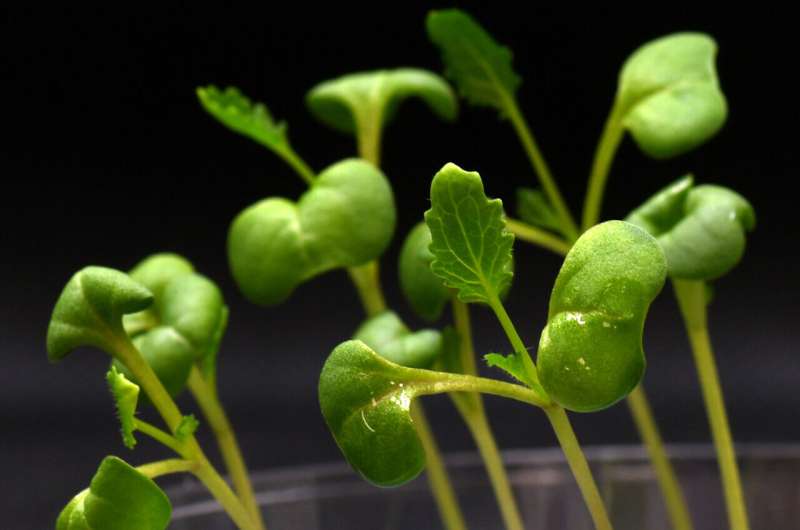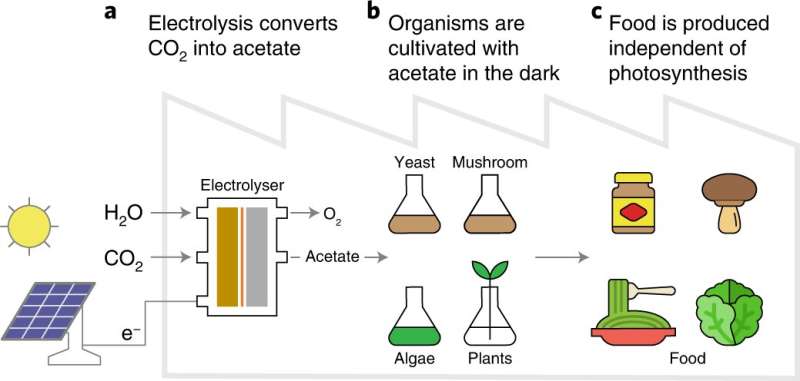 Plants are growing in complete darkness in an acetate medium that replaces biological photosynthesis.
Plants are growing in complete darkness in an acetate medium that replaces biological photosynthesis. Posted on 06/23/2022 10:37:28 AM PDT by LibWhacker
 Plants are growing in complete darkness in an acetate medium that replaces biological photosynthesis.
Plants are growing in complete darkness in an acetate medium that replaces biological photosynthesis.
Photosynthesis has evolved in plants for millions of years to turn water, carbon dioxide, and the energy from sunlight into plant biomass and the foods we eat. This process, however, is very inefficient, with only about 1% of the energy found in sunlight ending up in the plant. Scientists at UC Riverside and the University of Delaware have found a way to bypass the need for biological photosynthesis altogether and create food independent of sunlight by using artificial photosynthesis.
The research, published in Nature Food, uses a two-step electrocatalytic process to convert carbon dioxide, electricity, and water into acetate, the form of the main component of vinegar. Food-producing organisms then consume acetate in the dark to grow. Combined with solar panels to generate the electricity to power the electrocatalysis, this hybrid organic-inorganic system could increase the conversion efficiency of sunlight into food, up to 18 times more efficient for some foods.
"With our approach we sought to identify a new way of producing food that could break through the limits normally imposed by biological photosynthesis," said corresponding author Robert Jinkerson, a UC Riverside assistant professor of chemical and environmental engineering.
In order to integrate all the components of the system together, the output of the electrolyzer was optimized to support the growth of food-producing organisms. Electrolyzers are devices that use electricity to convert raw materials like carbon dioxide into useful molecules and products. The amount of acetate produced was increased while the amount of salt used was decreased, resulting in the highest levels of acetate ever produced in an electrolyzer to date.
"Using a state-of-the-art two-step tandem CO2 electrolysis setup developed in our laboratory, we were able to achieve a high selectivity towards acetate that cannot be accessed through conventional CO2 electrolysis routes," said corresponding author Feng Jiao at University of Delaware.
Experiments showed that a wide range of food-producing organisms can be grown in the dark directly on the acetate-rich electrolyzer output, including green algae, yeast, and fungal mycelium that produce mushrooms. Producing algae with this technology is approximately fourfold more energy efficient than growing it photosynthetically. Yeast production is about 18-fold more energy efficient than how it is typically cultivated using sugar extracted from corn.
 A combined electrochemical–biological system for the production of food from CO2. a, CO2 electrolysis uses electricity (generated by photovoltaics) to convert CO2 and H2O into O2 and acetate. This process was optimized to produce an effluent output ideal for supporting the growth of food-producing organisms. b, Chlamydomonas, Saccharomyces, mushroom-producing fungus and a variety of vascular crop plants were grown using the electrolyser-produced effluent. c, The organisms grown using the electrolyser-produced effluent serve as food or food products. This system is capable of making food independent of photosynthesis, using CO2, H2O and solar energy.
A combined electrochemical–biological system for the production of food from CO2. a, CO2 electrolysis uses electricity (generated by photovoltaics) to convert CO2 and H2O into O2 and acetate. This process was optimized to produce an effluent output ideal for supporting the growth of food-producing organisms. b, Chlamydomonas, Saccharomyces, mushroom-producing fungus and a variety of vascular crop plants were grown using the electrolyser-produced effluent. c, The organisms grown using the electrolyser-produced effluent serve as food or food products. This system is capable of making food independent of photosynthesis, using CO2, H2O and solar energy.
"We were able to grow food-producing organisms without any contributions from biological photosynthesis. Typically, these organisms are cultivated on sugars derived from plants or inputs derived from petroleum—which is a product of biological photosynthesis that took place millions of years ago. This technology is a more efficient method of turning solar energy into food, as compared to food production that relies on biological photosynthesis," said Elizabeth Hann, a doctoral candidate in the Jinkerson Lab and co-lead author of the study.
The potential for employing this technology to grow crop plants was also investigated. Cowpea, tomato, tobacco, rice, canola, and green pea were all able to utilize carbon from acetate when cultivated in the dark.
"We found that a wide range of crops could take the acetate we provided and build it into the major molecular building blocks an organism needs to grow and thrive. With some breeding and engineering that we are currently working on we might be able to grow crops with acetate as an extra energy source to boost crop yields," said Marcus Harland-Dunaway, a doctoral candidate in the Jinkerson Lab and co-lead author of the study.
By liberating agriculture from complete dependence on the sun, artificial photosynthesis opens the door to countless possibilities for growing food under the increasingly difficult conditions imposed by anthropogenic climate change. Drought, floods, and reduced land availability would be less of a threat to global food security if crops for humans and animals grew in less resource-intensive, controlled environments. Crops could also be grown in cities and other areas currently unsuitable for agriculture, and even provide food for future space explorers.
"Using artificial photosynthesis approaches to produce food could be a paradigm shift for how we feed people. By increasing the efficiency of food production, less land is needed, lessening the impact agriculture has on the environment. And for agriculture in non-traditional environments, like outer space, the increased energy efficiency could help feed more crew members with less inputs," said Jinkerson.
This approach to food production was submitted to NASA's Deep Space Food Challenge where it was a Phase I winner. The Deep Space Food Challenge is an international competition where prizes are awarded to teams to create novel and game-changing food technologies that require minimal inputs and maximize safe, nutritious, and palatable food outputs for long-duration space missions.
"Imagine someday giant vessels growing tomato plants in the dark and on Mars—how much easier would that be for future Martians?" said co-author Martha Orozco-Cárdenas, director of the UC Riverside Plant Transformation Research Center.
What could possibly go wrong?
Frankenfood’s latest evolutionary leap
Chemosynthesis is what organisms deep in the ocean use to survive where there is no light.
https://en.wikipedia.org/wiki/Chemosynthesis
Preparations for the return of the Savior when he darkens the Earth for cries of repentance and remorse for being sinners, and yet there are none and they choose to continue in the Darkness...
May they find the Lord Almighty Father sooner rather than never (later will not be when to meet the Lord)
No thanks. I prefer my food WITH SUNSHINE. That's why I shop at Sunshine Foods...


They want to build moon communities in large comet craters. This might be cool to have dark plant farms for food. Or maybe work in underground survival shelters.
Just in time to save mankind form the massive increase of UVR caused by the collapse of the geomagnetic field....
No mushrooms for you.
“Plants are growing in complete darkness...”
But are they happy?
mushrooms...
Fascinating.
Can’t you just use the LED lights the pot growers use indoors???
You could use led lights, the fundamental limits are the efficiency of photosynthesis conversion of photonic energy to chemical energy via the ATP cycle it’s limited to 1% or so regardless of the light source.
Solar panels are 20+% efficient at turning a photon into electrons. This means you start off with at least 20 times the per square meter of sunlight in output of energy conversions. Then they use this much higher density of energy to turn water and CO2 into an organic molecule that plants,yeast or fungi can literally eat. It’s genus actually and will help humans leave this rock for the stars. It also allows for the underground growing of food using geothermal or nuclear energy no sunlight needed with high efficiency and density. Humans now have the means to survive a KT event scale impact by creating deep mine based shelters with nuclear or geothermal energy sources to clean water make oxygen via electrolysis and now directly make food via electrolysis. It should be noted that the primary energy sources in cattle rumens is also acetic acid produced via their microbial symbiotic relationship in their guts. You could feed cattle the output of this process directly and with a nitrogen source such as ammonia or urea grow cattle or sheep or goats completely off electricity ,water and CO2 it is nothing short of a quantum leap in human innovation. Science! For the big win.
Humans can live in caves, or nuke shelters
We have artificial light.
Maybe we can invent pods like in the matrix movie
Look at that diagram very carefully. Sure doesn’t look very efficient. Odd that they are using sunshine to power their operation. Let’s ramp that operation up to support a million people. Looks similar to the cold fusion just around the corner with no economic analysis.
I'll stick with these mushrooms. They grow in the sunshine...with the proper fertilizer. ;~]

There has been a number of companies who have used microbial life to make food be it protein or starches or lipids. The Soviets used naptha to grow microbial proteins for animal feed on a scale of millions of kg per year. The British used natural gas to do the same thing during the 1970s and 80s using methogenic bacteria. UT Austin GMO a cyanobacteria to grow and excrete glucose directly from it’s cellular membranes while growing in salt water. Glucose is the base molecule for all cellular respiration including humans it is what is in IV fluids given people who cannot eat you can live on glucose , protein and lipids given via IV fluids btw. UT then designed a Ecoli to take electricity and also excrete pure glucose using the hydrogen proton path way off one side of a electrolysis cell with CO2 dissolved like a soda in the water. They succeeded in turning salt water.CO2 and electricity into the base food for every life form on earth that is aerobic that means every mammal, every avian, and all other vertebrates like fish and reptiles. Every one of them has at the base of it’s biological imperative the need for 6 carbon glucose. Everything any of them eats is turned into glucose ultimately by the digestive process and used for cellular respiration. Humans have the technology to leap well above what nature has in efficiency by a factor of 20 or more. Our livestock could care less if they eat single cell protein or not. Same for carbohydrates they could care less if its glucose or sucrose or starches from GMO tanks or sugar cane fields or corn fields once in pelleted feed form they could care less.
And they will call it soylent brown.🙄
Disclaimer: Opinions posted on Free Republic are those of the individual posters and do not necessarily represent the opinion of Free Republic or its management. All materials posted herein are protected by copyright law and the exemption for fair use of copyrighted works.